
Welcome to Floriography! The article series allows you to understand the intricate language of flowers, and how they’re used. For this section, I’m proud to start with the flower that everyone should recognize: the rose.
Whether it’s the main plot device in Beauty and the Beast, or used as a symbolic tool in The Great Gatsby, roses have always been an important part of American culture. It doesn’t just extend to America however, as roses are the national flowers in countries such as England and Iraq, originating in 2,000 BCE in the countries we now know as Iraq, Iran, and Syria. It’s been known for its medicinal and fragrant properties, and it’s been heavily favored by important figures such as Cleopatra, Confucius, and even the Virgin Mary.
The most fascinating part about roses is their vast amounts of colors and the hidden meanings behind all of them. The most common example is, of course, the red rose, symbolizing romantic love and desire, which makes it the perfect Valentine’s gift. Though interestingly, it can also be used to represent heroism, sacrifice, and even secrecy and confidentiality.
White roses meanwhile represent innocence and new beginnings, and also for remembrance and reverence. That makes them great for weddings, which is where they get the nickname “bridal flowers”, and funerals.
Pink roses are used to represent sweetness and gratitude, with the darker shades meaning recognition and appreciation, while the lighter symbolizing gentleness and grace, making a fantastic thank you gift to anyone you admire.
Finally, yellow roses symbolize joy and warmth, along with deep platonic friendship. That makes it stand out from other roses, as it’s not typically associated with romance, making it the best present to give to your dearest friends and family.
There’s a reason why roses are among people’s favorites, as they can seem to fit any type of occasion for anyone you care about. It even makes sense to think that roses are the ultimate metaphor for love, with their alluring captivating fragrance that draws people in, the strong structural support shown by the stems, the painful, yet necessary reminders hidden in the thorns underneath, and the fragile and delicate petals that require nurturing to bloom, such as the nature of love itself.


